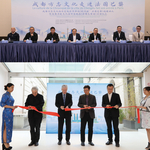DUBLIN--(BUSINESS WIRE)--The "Single-Family Housing Green Buildings Global Market Report 2022" report has been added to ResearchAndMarkets.com's offering.
The global single-family housing green buildings market is expected to grow from $105.26 billion in 2021 to $120.89 billion in 2022 at a compound annual growth rate (CAGR) of 14.8%. The market is expected to reach $209.34 billion in 2026 at a CAGR of 14.7%.
Major players in the market are Turner Construction Co., Clark Group, AECOM, Hensel Phelps, Holder Construction, Whiting-Turner Contracting Co., The Gilbane Building Co., Skanska USA, Structure Tone and Webcor Builders.
The main types of single-family housing green buildings are new constructions and remodeling projects. A remodelling project has a lot more levels and aspects than a renovation project. It usually entails removing and reinstalling the structure and functionality of an area using trades including plumbing, electrical and carpentry.
Asia Pacific is the largest region in the single-family housing green buildings market in 2021. Africa is expected to be the fastest-growing region in the forecast period. The regions covered in this report are Asia-Pacific, Western Europe, Eastern Europe, North America, South America, Middle East and Africa.
Greater consumer interest has contributed to the growth of single-family residential green buildings. Customers, particularly millennials, are showing more interest in sustainable and net-zero energy homes considering the environmental concerns as sustainable (green) building design include the use of natural and renewable sources. The increased awareness of the benefits associated with sustainable green practices such as less exposure to toxins and contaminants from building materials, reduced air pollution inside the residence, and improved environmental health/quality is propelling the market growth.
Consumers and builders are targeting towards achieving more sustainable homes and are focusing on minimizing carbon footprint by developing self-sustainable homes, termed as Net-zero homes. A Net-zero home produces its own energy locally and should aim to produce at least as much energy as it consumes. According to the Net- Zero Energy Coalition, in 2019, there were 5,000 net-zero energy single-family home in USA. These statistics show a trend of Net-zero homes in the residential construction market.
Higher costs, in general, hinder the buyer and the supplier to invest more in any market. The same applies to single-family homes which are very expensive compared to other homes. The high cost associated with green features and practices is a potential barrier to the expansion of the green building market. Green features and practices add 5 to 10% to construction costs and also increase remodeling costs by more than 10 percent.
Additionally, meeting high energy efficiency regulations can increase costs by $600 to $1,000 per unit. On top of these, obtaining green building certifications can also add significantly to the cost. Therefore, addressing the high costs for green features and practices will be essential to ensure that green building practices continue to expand.
Key Topics Covered:
1. Executive Summary
2. Single-Family Housing Green Buildings Market Characteristics
3. Single-Family Housing Green Buildings Market Trends And Strategies
4. Impact Of COVID-19 On Single-Family Housing Green Buildings
5. Single-Family Housing Green Buildings Market Size And Growth
5.1. Global Single-Family Housing Green Buildings Historic Market, 2016-2021, $ Billion
5.1.1. Drivers Of The Market
5.1.2. Restraints On The Market
5.2. Global Single-Family Housing Green Buildings Forecast Market, 2021-2026F, 2031F, $ Billion
5.2.1. Drivers Of The Market
5.2.2. Restraints On the Market
6. Single-Family Housing Green Buildings Market Segmentation
6.1. Global Single-Family Housing Green Buildings Market, Segmentation By Type, Historic and Forecast, 2016-2021, 2021-2026F, 2031F, $ Billion
- New Constructions
- Remodeling Projects
6.2. Global Single-Family Housing Green Buildings Market, Segmentation By Product Type, Historic and Forecast, 2016-2021, 2021-2026F, 2031F, $ Billion
- Interior Products
- Exterior Products
6.3. Global Single-Family Housing Green Buildings Market, Segmentation By Construction Type, Historic and Forecast, 2016-2021, 2021-2026F, 2031F, $ Billion
- Full Green
- Semi Green
7. Single-Family Housing Green Buildings Market Regional And Country Analysis
7.1. Global Single-Family Housing Green Buildings Market, Split By Region, Historic and Forecast, 2016-2021, 2021-2026F, 2031F, $ Billion
7.2. Global Single-Family Housing Green Buildings Market, Split By Country, Historic and Forecast, 2016-2021, 2021-2026F, 2031F, $ Billion
Companies Mentioned
- Turner Construction Co.
- Clark Group
- AECOM
- Hensel Phelps
- Holder Construction
- Whiting-Turner Contracting Co. The
- Gilbane Building Co.
- Skanska USA
- Structure Tone
- Webcor Builders
- Lendlease
- Clayco
- Suffolk Construction
- DPR Construction
- PCL Construction Enterprises
- Walsh Group The
- Balfour Beatty US
- BL Harbert
- Level 10 Construction
- Austin Commercial
- James G. Davis Construction
- JE Dunn Construction
- Power Construction
- Consigli Building Group
- McCarthy Holdings
- Hoffman Construction
- Brasfield & Gorrie
- Mortenson Construction
- Sundt Construction
- HITT Contracting
For more information about this report visit https://www.researchandmarkets.com/r/88lhoy
Contacts
ResearchAndMarkets.com
Laura Wood, Senior Press Manager
press@researchandmarkets.com
For E.S.T. Office Hours Call 1-917-300-0470
For U.S./CAN Toll Free Call 1-800-526-8630
For GMT Office Hours Call +353-1-416-8900










